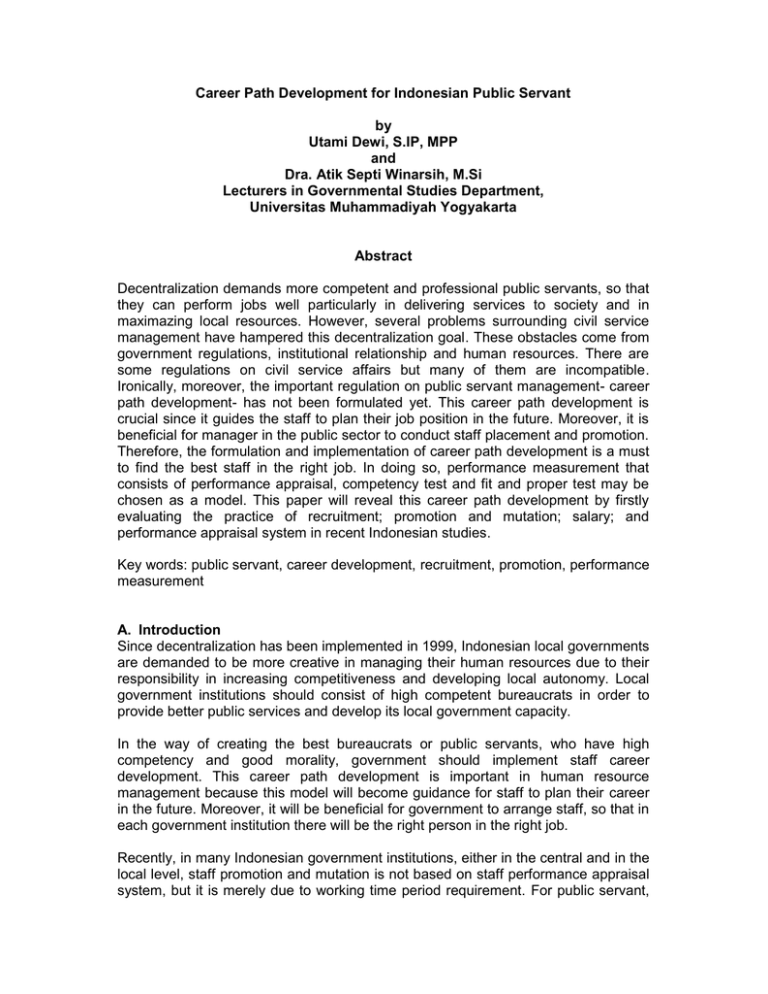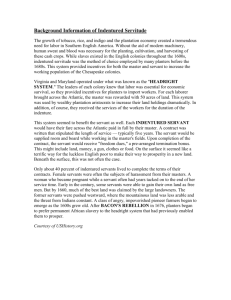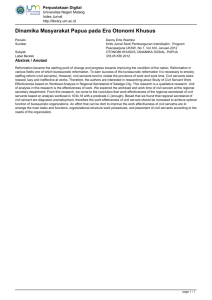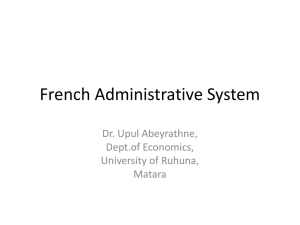Career Path Development for Indonesian Public Servant by Utami Dewi, S.IP, MPP and
advertisement

Career Path Development for Indonesian Public Servant by Utami Dewi, S.IP, MPP and Dra. Atik Septi Winarsih, M.Si Lecturers in Governmental Studies Department, Universitas Muhammadiyah Yogyakarta Abstract Decentralization demands more competent and professional public servants, so that they can perform jobs well particularly in delivering services to society and in maximazing local resources. However, several problems surrounding civil service management have hampered this decentralization goal. These obstacles come from government regulations, institutional relationship and human resources. There are some regulations on civil service affairs but many of them are incompatible. Ironically, moreover, the important regulation on public servant management- career path development- has not been formulated yet. This career path development is crucial since it guides the staff to plan their job position in the future. Moreover, it is beneficial for manager in the public sector to conduct staff placement and promotion. Therefore, the formulation and implementation of career path development is a must to find the best staff in the right job. In doing so, performance measurement that consists of performance appraisal, competency test and fit and proper test may be chosen as a model. This paper will reveal this career path development by firstly evaluating the practice of recruitment; promotion and mutation; salary; and performance appraisal system in recent Indonesian studies. Key words: public servant, career development, recruitment, promotion, performance measurement A. Introduction Since decentralization has been implemented in 1999, Indonesian local governments are demanded to be more creative in managing their human resources due to their responsibility in increasing competitiveness and developing local autonomy. Local government institutions should consist of high competent bureaucrats in order to provide better public services and develop its local government capacity. In the way of creating the best bureaucrats or public servants, who have high competency and good morality, government should implement staff career development. This career path development is important in human resource management because this model will become guidance for staff to plan their career in the future. Moreover, it will be beneficial for government to arrange staff, so that in each government institution there will be the right person in the right job. Recently, in many Indonesian government institutions, either in the central and in the local level, staff promotion and mutation is not based on staff performance appraisal system, but it is merely due to working time period requirement. For public servant, the regular promotion occurs every four year. It means that staff is promoted to the higher position just because he/ she has worked in their current position for four years or his/her experience is enough for getting the higher level position or echelon. If so, performance measurements are not the most significant factor to determine staff promotion procedure. Unlikely, many staff promotion happen due to list of rank stratification or even nepotism. Thus, career path development is vital for public servant in particular and the government in general to provide professional, high competent and good morality of civil servants. This paper aims to examine human resource management particularly public servant career development in the local government of Indonesia. In doing so, the paper will discuss on career path, staff’ promotion and rotation, performance appraisal and remuneration system. Staff career development in the public sector can be arranged from the recruitment process until staff’s retired period. In the first section of this paper, the writers will discuss general overview of human resources management before briefly illustrate the condition of Indonesian public servants in the secong section. The third part of this paper analyse the public servant management practices in Indonesia while the fourt part discusses career path development for Indonesian public servants. To sum up, the writers found that career path for local government staff is a crucial element that should be formulated and further implemented in order to place the best staff in the right job. B. Human Resource Management: A General Overview Human resource is a central factor in an organization. Organizations are created based on vision for coping human needs. Further, organization’s mission is also practiced by human being. Hence, human resource is a crucial strategic in every organization’s activities. If so, human resource management is necessary for any organization in order to attain organization’s vision and mission. Human resources management is part of management science that consist of planning, organizing, staffing, leading and controlling (Gullick, 2004). Human resources management is always develop as sciences development. Dessler (2000), states that in the era of globalization, strategic human resource management is the linking of human resource management with strategic role and objectives in order to improve business performance and develop organizational cultures and foster innovation and flexibility. Moreover, according to Noe and Hollenback (1994), human resources management has six dimensions: 1) job analysis; 2) recruitment process; 3) competence development; 4) performance management; 5) reward and punishment system; and 6) working relation. Regarding job analysis, manager in any organization can understand and determine duties and responsibilities of each job that in turn will be beneficial in finding out the right person to occupy the positions. Every job has different scale of responsibilities, from the simple one to the complex duties. Consequently, certain job types may need simple skill while another one requires more complete skills. Second, recruitment process is a process in which organization choose applicant to fulfil a certain job. Selection refers to the process to identify potential applicants who have education, skills, ability and characteristics needed by organization to attain its goals. Next, the third dimension of human resources management is human resources development itself. In this stage, there are two interrelated activities: training and development process. Training refers to efforts to facilitating learning of particular sciences and skill that is suitable for creating more professional staff. Meanwhile development opportunitines consist of efforts to improve staffs’ education, skills and attitude in order to enlarge staff capability in coping job challenges. Fourth, performance management is used to ensure that staffs’ activities and their results are relevant with organization’s goals. It requires specified activities and results as a guidance to attain organization goals. Fifth, salary structure is also play important role in managing human resources. By determining salary level of staff performance, organization can decide activities and performances demanded from the staff. Finally, working relation is a manner in which organization finds out capable staff to participate in decision making process, their rights and responsibilities. If so, every organization member can perform their jobs well. Moreover, there will be transparency in measuring staff performance since all of organization member understand their rights and responsibilities. As consequence, manager and organization in general will be more equal in giving reward and punishment. In relation to staff promotion, carrier path is an important tool to guide staff and organization in placing person in higher position. This path will be beneficial for organization to find competent staff and also for staff to plan their carrier in the future. It means that organization may take policies to promote staff in higher position without waiting enough service age as stated in regulation, but manager may appoint potential staff due to their achievements. Further, staff may plan their carrier - for example, after ten years from recruitment, they want to sit in the middle level manager – based on carrier path guidance. According to Ivancevich and Lee (2002), carrier path is stages in which organization rotate staff in different jobs in order to staff development in certain positions. The process of arranging carrier path has to consider the following aspects, as shown in Figure 1. Figure 1. Carrier Path Feedback Staff need & aspiration Staff counselling & apprasial Appropriate Needs and opportunities in organization Staffing and carrier information Staff development Appropriate Placing staff on carrier path Formal training and development programs Feedback Source: John C. Alpin & Darlene K. Gester in Ivancevich & Lee, 2002 Human Resource Management. Based on Figure 1, clearly stated that to determine carrier of staff, organization particularly manager should considers the needs of its staff. It is also important for manager to give opportunities for every member to develop. Moreover, supports from the management to its staff are vital in improving staff capability such as staff counselling, trainings and competence research. Even though carrier path is depend on individual staff capability, organization’s supports are significantly needed. In simple way, career development is the process of setting developmental goals and of identifying training and other developmental opportunities that will achieve those goals (Scheer, 2007). To be effective, an organization’s career development system must be integrated with the human resources program. The organization’s recruitment and selection system is a major source of job analysis information that should be fed into the identification of training needs, both to entry-level knowledge and skills and to prepare current employees for higher-level opportunities. In Indonesia, especially for its public servants, stages in human resources development is translated into eight primary activities, i.e. planning, recruitment, quality development, staffing, promotion, salary system, welfare system, and dismissal system (Law No. 43/199 Section 1 article 8). The capacity and competence development have to be planned in accordance to the regulations. So much so, civil servants could perform well since their ability is respected. C. A Brief Description of Indonesian Public Servant Based on data from The National Civil Service Agency (The National Civil Service Agency website, 2010), the total number of the public servants in Indonesia is 4.524.205 in 2009. Moreover, regarding the educational background, the number of civil servants who achieve higher education increase significantly every year. However, the largest number of Indonesian public servants are graduated from senior high school that occupy 35. 77 percent. Meanwhile the percentage of civil servant who achieved master degrees and doctoral degrees are only 2. 17 percent, below the total number of those who finished elementary school (2.34 percent) and junior high school (3.17 percent). This data shows that the educational background of public servant in Indonesia is still low. Table 1. Educational Background of Indonesian Public Servant per May 2010 No Educational Background Total Percentage (%) 1. Elementary School 110.816 2.34 2. Junior High School 150.353 3.17 3. Senior High School 1.693.115 35.77 4. Diploma 1 82.305 1.73 5. Diploma 2 710.104 15.04 6. Diploma 3 447.586 9.45 7. Diploma 4 11.729 0.24 3. Undergraduate degree (S1) 1.423.238 30.07 9. Master degree (S2) 93.512 1.97 10 Doctoral degree (S3) 9.714 0.20 TOTAL 4.732.472 100.00 Source: The National Civil Service Agency website, 2010. The educational background of the public servants, thus, is still not adequate to meet the quality requirements of human resources in the public sector. In high school or less level, the skills of analysis, critical thinking and problem solving are less taught compare to university level because in those levels, students are taught to develop their understanding about theories. In terms of golongan (rank), public servants are divided into four categories: rank I, II, III and IV. Rank I is the lowest level of whereas rank Iv is the highest level of public servant. As seen in Table 2, the majority of civil servant occupy rank III, about 47.43 percent. It is followed by Rank II (30. 81 percent) and rank IV (19.11 percent). The smallest percentage is rank I, about 2.65 percent. Table 2. The Proportion of Public Servant’s Rank per May 2010 No. 1. 2. 3. 4. RANK Rank I Rank II Rank III Rank IV TOTAL TOTAL 125.445 1.458.055 2.244.785 904.187 PERCENTAGE (%) 2.65 30.81 47.43 19.11 4.732.472 100.00 Source: The National Civil Service Agency website, 2010 In relation to educational background, those who graduated from elementary and secondary education occupy rank I in comparison to those in rank II who mostly finished senior high school. Rank III and IV are mostly come from civil servants who have finished their higher education, undergraduate, graduate and post graduate programs. D. Public Servant Management in Indonesia Human resources management in Indonesia has being concerned by the government. In fact, there are several revision of earlier human resources practices regulation to cope human needs and global development. Law No 18/1961 on Primary Determination for Civil Servant, judged is unable to accommodate changes needed at that time, was revised by Law No 8 on Primary Civil Service Affairs. Law No. 8/1974 determines Civil Servant’s positions, responsibilities, rights, and management based on career system and performance system. Then, as a consequence of policy changing on local autonomy, Law No. 8/1974 has been revised into Law N0.43/1999 on Revision of Law 8/1974 on Primary Civil Servant Affairs that has been implemented since 30 September 1999. Looking on the age of this last policy, the regulation of public servant affairs was revised after 25 years implementation. This means that there is a long period to accommodate society changes and human resources practices of civil services. Not all of sections in Law 8/1974 was changed. The revision covers 26 sections. It means that unchanged sections, made 25 years ago, are still be in effect as a guidance in public servant management. Public Servant Management as stated in Law 43/1999 section 1 number 8 is all effort to develop efficiency, effectively, and professionalism of public servant in maintaining jobs, functions and civil services responsibilities. These efforts consist of public servant planning, recruitment, quality development, staffing, promotion, salary, welfare and dismissal. Civil Servant management is aimed to ensure implementation of government duties and development in effective and efficient manner. Hence, Indonesian public servant should be professional, responsible and honest people that can be established through career system and performance appraisal system. 1. Recruitment System Since decentralisation, recruitment and selection is not arranged by the central government. Each regional government can arrange recruitment and selection for the public servants. However, the recruitment and selection process must adhere to the general and technical guidelines of the recruitment and selection process (Yuwono, 2001:59). Recently, recruitment process for public servant in the local level government is based on local government demand. The total number of new public servant recruitment proposal realized by the central government may vary for each local government. It means that sometimes the local government proposes the recruitment for 300 employees, but in reality the central government only grants 200 new employees. However, the problem arises since many local governments propose the need of new public servants to the central government without detail analysing on total number and qualifications needed with the availability of salary and the existence of contractual staff or honorarium staff. In many cases, the result of recruitment process is not match to the competency needed. It occurs because sometimes individual interest plays roles in the recruitment process. Consequently, the recruitment process is not free from corruption, collusion and nepotism. 2. Promotion and Rotation System Recently, staff promotion in the public sector is not based on performance appraisal but on administrative procedure. It means that staff usually achieves higher position as a consequence of rotation system based on working age period. Usually Indonesian public servant get higher rank for every four year regularly. Performance appraisal system seemed as a routine procedure that in fact is characterized by subjectivity measurement and is difficult to analyse. In addition, promotion for structural job is mostly taken by the spirit of “support rewarding” (Effendi, 2004). It means, the top level manager, often choose staff for structural position based on individual relationship. The closer the relation, the larger the opportunity to get higher position. This phenomenon occurs in the local level government due to the larger authority of local leader in managing local government staff. The function of Badan Pertimbangan Jabatan dan Kepangkatan/Baperjakat (Local Board of Job and Position’s Judgment) is not effective since the chair person is directly occupied by the local leader. If so, political interest often occurs in the process of structural position promotion in the local level government. As a result, it is often difficult to find competent and professional bureaucrats in certain field of jobs because some times they are appointed for serve the power holder. Meanwhile, for public servant rotation system, based on the Head of National Service Agency Decision No. 13/2002, the mutation can be taken in three options. First of all, horizontal mutation. It is a mutation system for structural position in the same echelon. Second, vertical mutation, is a mutation from the lower echelon to the higher level echelon. Finally, diagonal mutation. This mutation can be taken for functional into structural jobs and vice versa. The mutation or rotation system in local government indicates that the principle of the right man in the right job has not been implemented well. The reason is individual interest or nepotism often happens in the local government practices. 3. Performance Appraisal System The performance appraisal of the public servants called as DP3 (Daftar Penilaian Pelaksanaan Pekerjaan) (Rohdewohld, 1995, p. 105) is difficult to use because its’ intangible characteristic in some of the elements. The principal elements to be measured are loyalty, work achievement, responsibility, fidelity, honesty, cooperation, initiative and leadership in which the criteria for each element consist of five grades: very good (91-100), good (76-90), average (61-75), below average (5160) and fair (under 50) (The National Civil Service Agency website, 2007b). The elements such as loyalty, honesty, and fidelity have an intangible characteristic. For these elements, it is hard to set certain standards to determine the score to be given. As a result, subjectivity appears in the performance appraisal (Putranto, 2001:323). The performance appraisal is confidential. The appraiser must be a person who already supervises the public servant at least for six months (The National Civil Service Agency website, 2007). The result of the evaluation will be given to the public servant and the evaluator’s supervisor (Rohdewohld, 1995:105). The public servant can appeal if he/she objects to the result in fourteen day after the result accepted (The National Civil Service Agency website, 2007b). However, it is difficult to propose an appeal if the public servant still want to work because an appeal is seen as a rude act of challenging to supervisor. To achieve the objectivity of performance appraisal system, this measurement should be judged not only from the supervisor of public servants but also from the colleagues in the same department/bureaus and from the subordinate level. Moreover, the elements of measurement should be broaden into tangible characteristics. Thus, it is beneficial to determine their measurement indicators or scores. Good performance appraisal should more emphasized on tangible characteristics such as “employee’s knowledge of his/her job duties, attitude toward his/her work, ability to work independently” (Camardella, 2003:105), employee’s productivity, employee’s initiatives or ideas because these characteristics are more easily to be measured and can show the real achievements done by the employees. For example, employee’s knowledge of his/her job can be measured from how many tasks done by the employee without asking his/her supervisor or colleague and how long the employee accomplishes one task. Another example is for employee’s initiatives or ideas, the measurement can be such as how frequent does the employee share his/her ideas, does the employee find a solution with his/her own thoughts when facing a problem, does the employee finish his/her tasks by following procedure or create a new way which is also legal. Given these characteristics, the public servants will be treated fairly because those characteristics will minimize subjectivity. 4. Trainings and Developmental Opportunities The government realises that to improve the skills and abilities of public servants, training and development should be done as the government knows that many public servants are high school graduates. Based on Government Regulation No.101/2000 on Education and Trainings for Public Servant, it is stated that trainings for civil servant can be divided into two types: pre-job training and on-job training. Pre-job trainings is a training as a requirement to be appointed as civil servant while on-job training is a training during staff is being the public servant. Pre-Job trainings is divided into pre-job training for rank I, rank II and rank III whereas on-job training is divided into leadership trainings, functional trainings and technical trainings. Leadership training is trainings to improve staff’s education, skill, attitude and behaviour in the field of apparatus leadership to achieve competence requirements for certain structural position. This leadership training is differentiated for every echelon. It means that in each echelon there is a different type of leadership training. For example there is leadership training IV for those who obtain echelon IV, leadership training III for echelon III, and so on. Another on-job training, functional trainings, are trainings to improve competency of public servants who will occupy or on going sit in particular functional job position. The types of this functional trainings vary depend on institution for certain functional jobs. The last on-job training is technical trainings. Technical trainings in Yogyakarta Special Province, for example, based on Governor Regulation No. 24/2007 are differentiated into General Technical, Administration and Management training ; and Substantive Technical Trainings. The first is general training to improve general competency especially for administration and management skill that support certain institution while the second training aims to develop technical skills of particular job that may differ for every bureaus. In the central level, the government has appointed The National Institute of Administration to arrange training for all public servants. Each ministry also has its own training, however, the training held by The National Institute of Administration is seen as more important especially when a public servant wants to be promoted in the future. As a result, the public servants who have higher education will obtain more training than those who have less education (Report A, 1997, as cited in Bennington and Habir, 2003:385). Structural and functional training are types of the training in the public sector (Yuwono, 2001:60). Rohdewohld (1995:108) explained that structural training is held for public servants’ career development that are in a structural position. The functional training is held for the public servants in functional positions such as medical doctors, librarians and lecturers. However, the substance of the training which is to increase professionalism and capabilities of the public servants in doing the tasks are disappearing. Training is more likely to be means for additional income, to be promoted, and “moonlighting” (Report A, 1997 as cited in Bennington and Habir, 2003:384-385). Therefore, the skills of the public servants do not improve and cause inefficiency and tardiness in servicing the public. The training and development for the public sectors do not emphasis specific skills needed to be improved because most of the training is only about general skills and abilities needed by the public servants to do the tasks or to have promotion. Tilden and Kleiner (2005:50) explain that competency should underpin the training programs. By using competency-based training, the public servants who have a lack in skills will improve, thus, this also will allow less educated people to receive training. If the training and development programs in the public sector are designed to meet the need of the specific skills from the jobs, ineffective, tardiness and time consuming which are always found in the job practices of the public servants (Gie, 2003:5) will be overcome. In some cases of local government, furthermore, much training is ineffective in boosting public servants’ capability due to lack of good human resources management. Many public servants have sent to attain several trainings but they cannot implement what they got from those trainings because of many reasons, such as too old to follow particular trainings or uninteresting trainings. Therefore, public servants’ trainings should be planned well. To do so, the organization may choose the right person to follow particular trainings. Not all public servants have to attend technical trainings for example, but those who have higher capability or relatively young public servant are more nominated. Moreover, the organization may take post test after sending its public servants to take courses or trainings in order to measure education and skill that they have got during trainings or courses. This measurement will be a part of performance appraisal to give reward to the civil servants. 5. Remuneration System The income of the public servants is based on three components which are “basic salary, allowances and other salary supplements” (Rohdewohld, 1995:101-102). Basic salary for the public servants in Indonesia is based on a “Combination Scale System” which refers to “a combination of single scale system and double scale system”. Under the combination scale system, some public servants will receive higher salary than those who are in the same rank or level (Tjiptoherijanto, 2006:5). Allowances received by the public servants include “rice and family allowances, structural allowances, functional allowances and special allowances for the civil servants working in remote areas” (Rohdewohld, 1995:101; Yuwono, 2001:62). In addition, other salary supplements will be received when special or certain events take place such as Idul Fitri bonuses (the moslem holy day, but all public servants regardless their religion will have this bonuses), project bonuses, official travel, and health care (Rohdewohld, 1995:102). However, the low rate of remuneration can not be seen as an exception to have less performance in doing tasks. The public servants have to be responsible in doing tasks with their best efforts. The low salary is the reality that they have to accept since they already know when they apply to become public servants. Remuneration is one important aspect of human resource management that should be considered. Other elements, such as recruitment, promotion and mutation, performance appraisal and training and developmental opportunities are also vital in managing public servants. If those aspects were planned and managed well, there would be professional and competent public servants in Indonesia. Nevertheless, without providing career path development, the staff in particular and public sector organization in general will find difficulties in placing the right person in the rightt job. Hence, this paper emphasis in altering career path development as a vital tool for Indonesian public servant management. E. Guidance for Planning Career Path Development : An Alternative After more than ten years since Law 43/1999 has been implemented, career path regulation for Indonesian public servants has not been formulated. This career path is crucial as a guidance for civil servant’s career development and capacity. If career path regulation were available, public servant’s promotion for structural position may be taken transparent and equal for every staff. Further, each individual of civil servants may determine his/her career path or plan for future career and also certain position for certain working period, for example ten years. Moreover, Indonesian public servant’s career path development, in fact, is mostly based on seniority and list of rank stratification. Several Government Regulations support this condition and do not accommodate performance appraisal system such as Government Regulation No. 15/ 1979 on List of Rank Stratification; Government Regulation No. 13/2002 on Public Servant Promotion in Structural Position; and Government Regulation No. 12/2002 on Public Servant Promotion of Position (Tri Putranto, 2009: 135). In this paper, the writers propose that public servant career path can be based on three primary elements: performance appraisal, competency test and fit and proper test. Those three aspects are used to manage staff’s career path development since staff recruitment process until staff retired period. Through this model, career path is begun since public servant is recruited by employing job analysis and work load analysis. By doing so, identification of new employee’s need can be taken to determine its competency requirements and its quantity. The potential candidates will be recruited and selected through several test phases, such as administrative, potential academic, psycho test and interview to measure attitude and performance. For certain job positions, health test and practical test may be taken to obtain competent staff. By conducting several type of tests, the local government would receive the best civil servant who have high competency and good morality. Next, those new public servants have to attend pre-job trainings and on-job training to develop their capabilities and skills. To obtaining certain functional position, public servants have to complete technical trainings. Meanwhile, to achieving structural position, civil servant have to finish leadership training depend on each echelon. These leadership and technical trainings are aimed to prepare public servants who are capable to be put in particular job position. During their occupancies in certain job position, either functional or structural position, public servants are regularly evaluated by conducting competency test and performance appraisal practices. If public servant has more competence in managerial and leadership competency, he/she may be placed in the structural position rather than functional position. Meanwhile, if civil servant has high performance in technical analysis, he or she can be put in the functional position. Hence, the result of competency test and performance appraisal can be guidance in deciding whether public servant can ne promoted into higher position or not. Career development in structural position is also required to master technical or special competency, particularly for lower manager and middle level manager (echelon IV and III). In this level of echelon, staff has to conduct operational of technical jobs than leadership skills. Whereas for top level manager or echelon I and II, fit and proper test is put on emphasis since their responsibility is mainly concerned in decision making or policy making. Therefore, in planning career path several elements are important: performance, competency, education and development opportunities, job position, board of fit and proper test and transparency level. Figure 2. Career Path Development Model Based on Performance Appraisal Credit Measurement Retired Age Limit (56 years old) Primary Middle Echelon I Training PA, CT, FPT Leadership I EchelonII Training PA, CT, FPT Laeadership II Young EchelonIII Training PA, CT Leadership III Preliminary EchelonIV Training PA, CT LeadershipIV Certain Promotion Placement NOTE PA : Performance Appraisal CT : Competency Test FPT : Fit and Proper Test Recruitment and selection From the above figure, it can be seen that in career development, there are three paths, structural path, functional path and diagonal path. Diagonal path is a promotion procedure or job replacement from structural into functional path and vice versa in the same level of job position. For example, young functional position may be moved or promoted to structural position especially in the level of echelon III with the requirement to finish leadership training III and to pass performance appraisal and competency test. In turn, public servants can obtain echelon II and I if they have finished Leadership Training I and II, have passed performance appraisal, competency test and fir and proper test. Credit point measurement is a point of each activity and or accumulation of activities achieved by functional staff in order to managing their career. Measured activities are each duty implemented by functional staff that consists of primary tasks and secondary tasks; tasks for supporting primary duties. Primary task is public servants’ responsibilities explained in job description while secondary task is social functions that support their primary role as public service delivers. In maintaining primary tasks, a public servant has collect at lest 70 percent or 80 percent of credit point, meanwhile it is only 30 percent or 20 percent credit point in maximum for secondary tasks. This regulation aims to ensure that functional staff prioritizes primary duties than secondary duties. Besides, credit point measurement, other important aspects of career path development is recruitment and selection system, placement, and promotion and mutation system. Recruitment and selection for public servant should represent merit system rather than nepotism and collusion. To do so, there should be transparency from the announcement until recruitment test. After recruiting staff, the next step to plan career development is placing the right person in the right job. New public servants are placed in their job position based on institution’s need assessment. Then, they will obtain training, pre-job training and on-job trainings as well. Regarding promotion system, promotion is a reward given for public servants who perform well in their jobs. By promotion system, public servant will achieve higher position with larger responsibility. In another aspect, those staff will also receive bigger financial salary. Promotion, usually called as vertical rotation, then should be based on achievement or merit system (Werther, 1996: 261). In deciding whether staff is capable or not to be promoted, career path development is determined by performance measurement system. For this reason, there are three kinds of test conducted to promote public servant into higher position: performance appraisal (PA), competency test (CT) and fit and proper test (FPT). Aspects of measurement for performance appraisal are discipline, working achievement; responsibility; working relationship; honesty; initiative and leadership. Meanwhile competency test aims to measure staff competency, relevant or not for the certain job. Aspects of measuring competency cover integrity, leadership, planning and coordinating, relationship and flexibility. Lastly, fit and proper test includes aspects of intellectual quotient, personality and environmental acceptance. In terms of job cluster, job grouping of public servants is beneficial to improve their education and skill in the similar job cluster that in turn may affect to increasing performance quality. Recently, functional job cluster has been regulated in Presidential Decision No. 87/1999 but for structural job has not regulated yet. Job cluster for top level managers (echelon I and II) are wider than for middle and lower managers. It means that for echelon I and II who play more roles in decision making process have to master several field of education and skills. Meanwhile for echelon III and IV, job cluster is more in closed system and rigid, meaning that mutation or promotion should be taken in the same or similar job group. F. Conclusion and Recommendation Public servant in Indonesia, recently, has not been managed well. Even though there are several government regulations, the implementation of those policies are far from ideal. Many cases of corruption, collusion and nepotism often occur in recruitment process, promotion and even performance appraisal. Other problems in managing civil servants come from regulations, institutional and human resources problem. Many public servant regulations are old fashion. This means that these regulations cannot cope the newest condition. In addition, several regulations are in contradiction, for example law product is incompatible with it’s implementation regulations. Even, career development regulation, a vital aspect in managing public servant, has not been formulated yet. Regarding institutional hindrances, institutional responsibilities for managing and policy making are overlap. Consequently, management for public servant becomes a conflict for those institutions due to ineffective relationship. Moreover, the quality of Indonesian public servant is still low that contribute to lower quality of working performance. To solve these problems, especially in formulating career path development, several recommendations should be taken. 1. Career development should be based on performance measurement. To do so, performance appraisal has to be revised. The aspect of performance appraisal should be more tangible and should be based from three elements: the supervisor, colleagues and subordination. Three types of measurements can be taken into account: performance appraisal, competency test and fit and proper test. 2. Promotion to the higher level job position may not be taken regularly but it can be based on working achievement and merit system. 3. Salary earned can fulfil the public servants’ average basic needs. Besides that, to enhance individual performance, incentives or bonuses that depend on the result of their jobs or their performance appraisal can be given. 4. Training and development are arranged more by each department because they know specific skills need to be developed. Before training is held, public servants need to be assessed in order to select people who really need to be trained. Public servants that already trained need to receive an advance training to improve their skills. References: Agustinus 2005, Sistem Pendayagunaan Aparatur, Bandung, Lembaga Administrasi Negara. Dessler, Garry. 1999. Human Resources Management. London, Prentice Hall. Effendi, Akhyar 2009, Manajemen Pegawai Negeri Sipil yang Efektif, Bandung, Lembaga Administrasi Negara. Ivancevich & Lee, 2002 Human Resource Management. London: Prentice Hall Rohdewohld, Rainer, 1995 Public Administration in Indonesia, Melbourne, Montech Pty Ltd. Schuler, et al. 1992. Human Resources Management in Australia, 2nd edition. Harper Educational. Tjiptoherijanto, Prijono 1997, Prospek Perekonomian Indonesia dalam Rangka Globalisasi, Jakarta, Rineka Cipta. Thoha, Miftah., 2005, Manajemen Kepegawaian Sipil di Indonesia, Jakarta, Prenada Media. Regulation: Law No.43/ 1999 on Revision of Law 8/1974 on Primary Civil Servant Affairs. Government Regulation No. 13/2002 on Public Servant Promotion in Structural Position Government Regulation No. 12/2002 on Public Servant Promotion of Position








